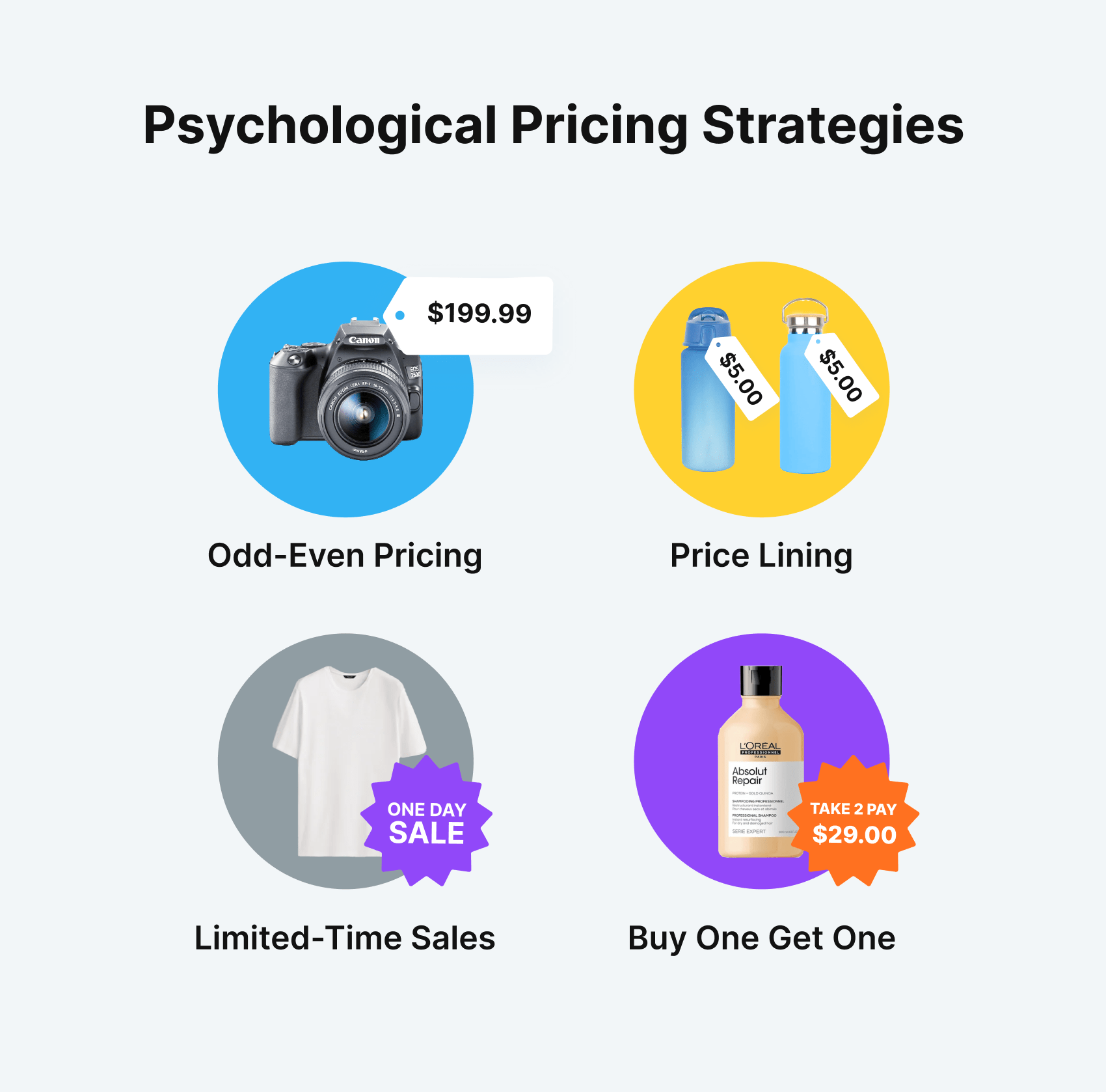Content navigation:
- Introduction
- The four product lifecycle pricing strategies for different stages
- Tips for eCommerce pricing
- Pricing in the introduction stage
- Pricing in the growth stage
- Time to start monitoring the market?
- Pricing in the maturity stage
- Pricing in the decline stage
Understanding the life cycle pricing definition as well as the four basic stages of the product life cycle is crucial in modern retail. From introduction and growth to maturity and decline, each phase presents unique challenges and opportunities for a business.
A key factor in navigating these stages successfully is implementing the right pricing strategy at the right time. Pricing strategies tailored to each stage can significantly impact a product's success, influencing consumer perception, market positioning, and revenue generation.
In this article, we will delve into the life cycle pricing definition and the importance of using the appropriate pricing strategy at each stage. We will also explore how businesses can optimize their pricing approach to maximize profitability and market share throughout the product's journey. Let's jump right into business!
The four product lifecycle pricing strategies for different stages
First of all, let's make a disclaimer that in this article, we're going to focus on the product lifecycle traditional classification, i.e. one that distinguishes product introduction, growth, maturity, and decline stages.
Note that the product roles and types, like traffic-generators, long-tail items, or KVIs, may also change depending on the product lifecycle stage. If you want to find out more about the changing roles of SKUs, read our guide dedicated to the topic.
Below in the article, we're going to consider each stage of pricing over product life cycle more thoroughly. To start with, take a look at the major aspects that should be considered while pricing over the life cycle of a product:
- In the introduction stage, life cycle based pricing should focus on setting a price that reflects the product's value and covers initial development costs. This stage often involves consideration of skimming or penetration pricing strategies, depending on the market dynamics and competitive landscape.
- During the growth stage, pricing can be adjusted to maximize market share and capitalize on increasing demand. Businesses may choose to maintain prices or even lower them slightly to attract more customers and solidify their position in the market.
- The maturity stage requires pricing strategies aimed at maintaining market share and profitability. This may involve offering discounts, bundle deals, or other promotions to incentivize continued purchases from existing customers while also attracting new ones.
- In the decline stage, life cycle based pricing strategies typically focus on managing the product's decreasing popularity. This may include price reductions to clear out remaining inventory or phasing out the product entirely. You must carefully consider diverse pricing factors to minimize losses and manage the transition smoothly.
Tips for eCommerce pricing
Before we take a closer look at how to capitalize pricing over the life cycle of a product, let's recap the major eCommerce pricing tips. It's important to remember and use them as they apply to pricing strategies at different stages of product life cycle.
Following these eCommerce pricing tips will help you to stay competitive with SKUs at diverse product lifecycle stages:
- Monitor costs closely. Continuously evaluate your costs to ensure your pricing remains profitable. This is crucial at every stage to avoid pricing your products too low and eroding margins.
- Utilize data analytics. Use data analytics to track sales trends, customer behavior, and market conditions. This information can help you make informed pricing decisions at each stage of the product lifecycle.
- Regularly review and adjust prices. Regularly review your pricing strategy and adjust prices as needed based on market conditions, customer feedback, and product performance. This flexibility is key to staying competitive and maximizing revenue.
- Focus on value communication. Clearly communicate the value of your products to customers through your pricing strategy. Highlighting the benefits and unique features of your products can justify higher prices and drive sales.
- Implement pricing psychology tactics. Use pricing psychology tactics, such as anchoring or bundling, to influence customer perceptions and increase sales. These tactics can be effective at every stage of the product lifecycle in driving customer interest and boosting revenue.

Pricing in the introduction stage
During the introduction stage of the product lifecycle, pricing plays a crucial role in shaping customer perceptions and establishing a market position.
A sustainable way to set an optimal initial price is based on two factors:
- accurate evidence-based consumer decision tree
- precise selection of the most similar products sold in the past
The role of AI-driven analytics at the introductory stage can hardly be overestimated. In particular, you can select and analyze similar product sales is to using AI algorithms that compare all products’ credentials (including images, descriptions, etc.) with computer vision, tabular data, and natural language processing.
Another important consideration is choosing between skimming or penetration pricing strategies. Skimming involves starting with a high price and gradually lowering it, while penetration pricing starts with a low price to quickly gain market share.
Pricing in the growth stage
In the growth stage of the product lifecycle, pricing strategies aim to maximize market share and capitalize on increasing demand. It's crucial to maintain competitive pricing to attract customers and fend off competitors. Pricing can be adjusted slightly to ensure profitability while still offering value to customers. This stage also presents opportunities to introduce bundle pricing or volume discounts to encourage larger purchases.
Here are the two pricing approaches that can be particularly fruitful for SKUs at the growth lifecycle stage:
- Dynamic life cycle pricing strategy: Consider implementing dynamic pricing strategies to adjust prices based on demand and market conditions, maximizing revenue during periods of high demand.
- Value-added life cycle pricing strategy: Explore value-added pricing by offering additional services or features with the product, allowing for higher prices and increased perceived value.
Time to start monitoring the market?
Smart competitor price monitoring is an essential element of a retailer's pricing strategy for SKUs at the growth lifecycle stage. As demand increases and competition intensifies, you need to stay agile and responsive to changes in the market. By monitoring competitor prices in real-time, you can adjust their pricing strategy accordingly to remain competitive while maximizing profitability.
This approach involves using automated tools and software to track competitor prices across a wide range of products. For example, using Competera's solution for monitoring, you can schedule scraping according to your requirements – once a month, a week, a day, or even every 15 minutes. By analyzing pricing over the life cycle of a product, the platform can identify pricing trends, price gaps, and opportunities to adjust prices to gain a competitive edge.
Pricing in the maturity stage
In the maturity stage of the product lifecycle, pricing strategies should be focused mainly on maintaining market share and maximizing profitability.
One approach is to use price discounts or promotions to incentivize continued purchases from existing customers while attracting new ones. Besides smart promo management, you can also these pricing strategies in product life cycle:
- Price Leadership: Consider establishing price leadership by setting prices slightly below competitors to maintain or gain market share.
- Loyalty Programs: Implement loyalty programs or rewards to retain customers and encourage repeat purchases. Loyalty programs can help leverage pricing as a key component of customer retention.
Pricing in the decline stage
In the decline stage of the product lifecycle, pricing strategies are aimed at managing the product's decrease in popularity while minimizing the potential revenue loss for the business.
The simplest thing you can do is to gradually reduce prices to clear out the remaining inventory. This can be done through price markdowns, discounts, or bundle offers to stimulate final sales. Another strategy is to focus on selling the product to loyal customers or niche markets that may still value the product.
Markdowns are aimed at hitting the stock level but they should also not undermine your price perception. Besides, it is essential to reduce the prices step-by-step to make sure the margin losses are minimized. And this is where pricing software, like Competera, can help. Here's what you get with the AI-driven markdowns as a part of pricing strategies in product life cycle:
- Discount differentiation at SKU-level
- Maximized margin
- Suggestions on sequential discounts and predictions on hitting stocks
The point is that you can hardly sustain optimal prices at every stage of the product lifecycle without leveraging advanced technology. Contact us to find out more about how can Competera help with product life cycle and pricing strategies.






